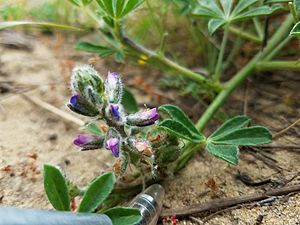Nipomo Mesa lupine facts for kids
Quick facts for kids Nipomo Mesa lupine |
|
|---|---|
 |
|
| Conservation status | |
| Scientific classification | |
| Genus: |
Lupinus
|
| Species: |
nipomensis
|
The Lupinus nipomensis, also known as the Nipomo Mesa lupine, is a special kind of lupine plant. It grows only in one small area of California, specifically in the Guadalupe-Nipomo Dunes along the California Central Coast. This means it is endemic to that spot, found nowhere else in the world!
This rare plant lives in the Guadalupe Dunes, which are located at the southern edge of San Luis Obispo County, California. There are only about five to seven groups, or "colonies," of these plants. They grow in a strip of sand dunes that is less than three square miles big. All these colonies are usually thought of as one single group of plants. The number of individual plants changes a lot, from about 100 to 1,800. Scientists are still trying to understand why the numbers vary so much. Because it's so rare, the Nipomo Mesa lupine is listed as an endangered species by both California and the U.S. government.
What it Looks Like
The Nipomo Mesa lupine is a small plant that spreads out along the ground. It's an annual herb, which means it lives for only one growing season. Its stem can grow to be between 10 and 50 centimeters long.
- Leaves: Each leaf looks like a hand with 5 to 7 narrow, juicy leaflets. These leaflets are about 1 to 1.5 centimeters long and only a few millimeters wide.
- Texture: The plant usually feels hairy, but sometimes it can be smooth. New stems grow out in groups of three, spaced evenly.
- Color: When the young plants first pop up, they have a reddish-purple color. This color comes from something called anthocyanin, which helps protect the plant from harmful ultraviolet rays from the sun.
- Flowers: The flowers grow in a small, crowded cluster called a raceme. Each flower is about 6 to 7 millimeters long. They are pink with a lighter spot, sometimes yellowish, on their top petal.
- Fruit: After flowering, the plant produces a legume pod, which is a type of fruit. These pods can be up to 2 centimeters long.
Plant Interactions
Scientists haven't found any specific animals that regularly pollinate this plant. However, the Nipomo Mesa lupine does interact with many different kinds of arthropods (like insects and spiders).
One interesting visitor is a type of sand weevil called Trigonoscuta. These weevils might also be rare and only found in sand dunes. The plant can also be negatively affected by a gall maggot, Delia lupini, from the family Anthomyiidae. This maggot creates galls (small, abnormal growths) on the plant. Once the maggots leave, other pests, like Scaphomorphus beetles, have been seen living in these empty galls.
Protecting This Plant
The Nipomo Mesa lupine only grows in a small area of sand dunes, and all of this land is privately owned. This makes conservation efforts tricky.
The biggest dangers to this plant's survival include:
- Invasive Plants: Other plants that are not native to the area, especially a type of grass called perennial veldtgrass (Ehrharta calycina), can take over the space and resources that the lupine needs.
- Animals Eating Them: Animals like the Botta's pocket gopher (Thomomys bottae) eat the plants, which is called herbivory.
- Habitat Loss: Changes in how the land is used can destroy the plant's home or break it up into smaller pieces. This is called habitat fragmentation.
Recent studies have shown that these lupines need very specific small areas, or "microhabitats," to grow well. Understanding these preferences can help improve efforts to save the plant. Scientists and other groups are working together to create plans to protect the Nipomo Mesa lupine and keep it from disappearing forever.


